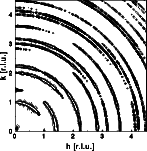Powder diffraction: preferred orientation

Powder diffraction
Few crystals
Powder pattern
Preferred orientation
Pair distribution function
Interactive examples
PDF simulator
Goto
Contents



The left image above shows the previous pattern obtained from 200 randomly orientated grains. The middle image shows the diffraction pattern obtained from 200 randomly oriented crystals. The right images shows the diffraction pattern of 200 crystals with preferred orientation. The [100] direction of the crystals is Gaussian distributed around the [100] direction of real space. The sigma of the distribution was set to 3.0 degrees. The powder diagram along [h00] for the random orientations (blue curve) and for the preferred orientation example (red curve) are shown in the right figure. Despite the identical number of reflections, several powder lines are completely missing and the intensity of other lines is very misleading. Preferred orientation can substantially alter the appearance of the powder pattern. It is a serious problem in experimental powder diffraction.